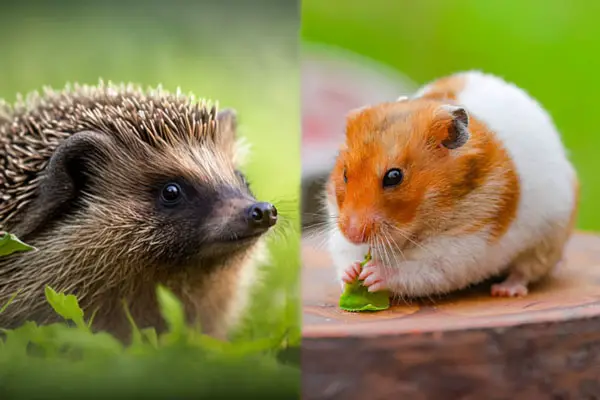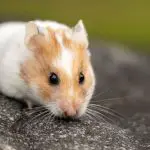A Comprehensive Guide to Choosing: Hedgehog vs Hamster
Are you ready to add a new furry friend to your family? With so many options available, it can be hard to choose the perfect pet. But don’t worry, you’ve got this!
So how to choose between Hedgehog vs Hamster? Choosing a pet between a hedgehog and a hamster involves considering factors such as size, maintenance, and temperament. Hedgehogs are larger and require a specific diet and habitat, whereas hamsters are smaller and easier to care for, but more active.
In this comprehensive guide, we’ll give you all the information you need to choose between a hedgehog and a hamster, two of the most popular small animal pets. So let’s dive in and explore what makes these two furry friends so special!
Choosing Between Hedgehog vs Hamster: Physical Characteristics
Let’s see the basic difference between a hedgehog and a hamster so we can see what’s best for you. Every animal has their own needs and physical characteristics differ too.

Here’s a table summarizing the physical characteristics of hedgehogs and hamsters:
| Species | Size | Weight | Coat and Spikes/ Coat and Color | Lifespan | Color/Tail |
|---|---|---|---|---|---|
| Hedgehogs | 20-30 cm, 15-20 cm in African pygmy | 400-600 g with 200-400 g in African pygmy | Dense fur with 1 cm spikes | 4 to 5 years | Brown, grey, white, black, tan |
| Hamsters | 10-15 cm, 20 cm in Syrian | 100-150 g with 400 g in Syrian | Soft, thick fur | 2 to 3 years | Brown, gray, black, white, golden (with distinctive markings in the tail) |
Physical Characteristics of Hedgehog
Size
Hedgehogs are small, compact animals with an average length of 20-30 cm and the African pygmy hedgehog is the smallest species, reaching a length of only 15-20 cm.

Weight
The average Hedgehog weight is 400-600 grams, while the African pygmy hedgehog can weigh up to 200-400 grams
Coat and Spikes
Hedgehogs are covered in a dense coat of fur that helps to protect them from predators and the environment. The most distinctive feature of hedgehogs is their spikes. And the spikes are approximately 1 cm long and are made of keratin, the same material as human nails.

Color
Hedgehogs come in a variety of colors, including brown, gray, and white. Some species may also have black or tan markings. The underbelly is typically lighter in color than the rest of the body.
Physical Characteristics of Hamsters
Size
Hamsters are small rodents with an average length of 10-15 cm and the Syrian hamster is the largest species, reaching a length of 20 cm.

Weight
Average Hamster weighs about 100-150 grams with Syrian hamster can go up to 400 grams.
Coat and Color
Hamsters have a soft, thick coat of fur that helps to keep them warm in their burrows. They come in a variety of colors, including brown, gray, black, white, and golden. Some species may also have distinctive markings, such as black stripes or patches.

Tail
Hamsters have short, stubby tails that are covered in fur and are barely visible. The tail is used to help balance the hamster when it is running or climbing. It is not prehensile, meaning it cannot grasp objects.
The Difference in Temperament: Hedgehog vs Hamster
Choosing the perfect pet for your home can also come to what you want in your pet. Some pets are active, thus taking your time and energy to go after them; some can be very low maintenance. Now we shall see the difference in temperament in hedgehogs and hamsters:
A table comparing the temperament of hedgehogs and hamsters
| Species | Socialization | Playfulness | Noisiness |
|---|---|---|---|
| Hedgehog | Shy and defensive, but friendly with proper socialization (solitary animals) | Active and playful, enjoys playing and exploring | Relatively quiet, may make small grunts or snorts |
| Hamsters | Solitary animals, can become aggressive if housed with other hamsters (friendly with proper handling and socialization) | Active and playful, enjoys playing with toys and exploring | Quiet, may squeak or make soft chirping noises |
The temperament of Hedgehogs
Socialization
Hedgehogs are solitary animals and do not typically enjoy the company of other hedgehogs or animals. They are known for being shy and defensive. They will often roll into a tight ball and puff up their spikes when Hedgehogs feel threatened.

However, with proper socialization and handling, hedgehogs can become friendly and docile pets.
Playfulness
Hedgehogs are active animals and enjoy playing and exploring their environment. They are generally nocturnal and are most active during the night. They enjoy running on wheels and playing with toys, but they can also be quite independent and content to play alone.

Noisiness
Hedgehogs are relatively quiet animals and do not make much noise. They may make small grunts or snorts when excited or alarmed, but they are generally not loud or disruptive.
The temperament of Hamsters
Socialization
Hamsters are generally solitary animals and do not do well in groups. They can become aggressive and territorial if housed with other hamsters, and keeping them in individual cages is best. However, with proper handling and socialization, hamsters can be friendly and affectionate pets.

Playfulness
Hamsters are active and playful animals that enjoy playing with toys and exploring their environment. They are most active at night and can be very entertaining to watch as they play.
Noisiness
Hamsters are generally quiet animals and do not make much noise. They may squeak or make soft chirping noises, but they are not loud or disruptive. However, some hamsters may become more active and noisy at night when they are most awake and playful.

The Difference in Care Requirements
Both the hedgehog and hamster have their care requirements. Though they are quite similar, there are some differences too. For example, their housing and diets. Let’s look further into this topic:
| Care | Hedgehog | Hamster |
|---|---|---|
| Housing | Spacious cage with wire mesh top, soft flooring, and hiding place. | Spacious cage with multiple levels and bedding material |
| Diet | Commercial food, Beetles, Earwigs, Caterpillars, Earthworms, fruits, vegetables, and freshwater. Avoid dog/cat food | Pellets, fresh fruits/veggies, occasional treats, and freshwater |
| Exercise | Play, explore, exercise wheel, dig in the dirt | Running wheel, exercise ball, toys, and supervised playtime |
| Vet Care | Regular check-ups and vaccinations are necessary | Annual check-up recommended |
For Hedgehogs
Housing
Provide a spacious cage that is at least 2 x 3 feet with a wire mesh top and soft flooring (such as aspen shavings). A hiding place is also recommended.

Diet
Feed high-quality commercial hedgehog food, fresh fruits, and vegetables, and always have fresh water available. They also like Beetles, Earwigs, Caterpillars, Earthworms, Millipedes, etc. You should avoid dog or cat food.
Exercise
For a fun workout, let your hedgehog play and explore outside of its cage. Give it a spinning exercise wheel so it may play and spin as much as it wants. Allowing your hedgehog to dig in the soil is another excellent kind of exercise for it.

Veterinary Care
Regular veterinary check-ups and vaccinations are necessary for your hedgehog’s health.
Hamster Care
Housing
A spacious cage with a minimum size of 24 inches (Syrian) or 18 inches (Dwarf) with multiple levels and bedding material like aspen shavings.

Diet
Make a balanced diet of pellets, fresh fruits/veggies, and occasional treats available with a fresh water supply at all times.
Exercise
Provide a running wheel/exercise ball and toys for stimulation. You can also provide supervised playtime outside of the cage for additional exercise and bonding.
Veterinary Care
A visit to the vet is not needed if your hamster is doing fine but once a year checkup is definitely recommended.

FAQs
Now we shall see some commonly asked questions people have regarding hedgehogs and hamsters.
Q: How Much Time Do Hedgehogs And Hamsters Need For Interaction With Their Owners?
Compared to hamsters, who are gregarious animals that benefit from regular engagement and playfulness with their owners, hedgehogs are more solitary creatures and do not need as much interaction with their owners.
Q: Are Hedgehogs Or Hamsters Better For Families With Children?
We advise choosing a hamster over a hedgehog if you have children. They are safer to have near children and easier to control. If not handled correctly, the hedgehog’s spiky spines may seriously harm.
Q: Can Hedgehogs And Hamsters Be Litter-Trained?
Yes, both hedgehogs and hamsters can be litter-trained with the proper training methods and consistency.
Conclusion
Choosing between a hedgehog vs hamster as a pet can be a tough decision. Both animals have their unique personalities, quirks, and needs. And it’s important to consider all of these factors before making a final decision.
Ultimately, the choice comes down to your personal preferences and lifestyle. So, do your research, ask questions, and choose the pet that’s right for you. And most importantly, enjoy the journey of discovering the joys of pet ownership!




